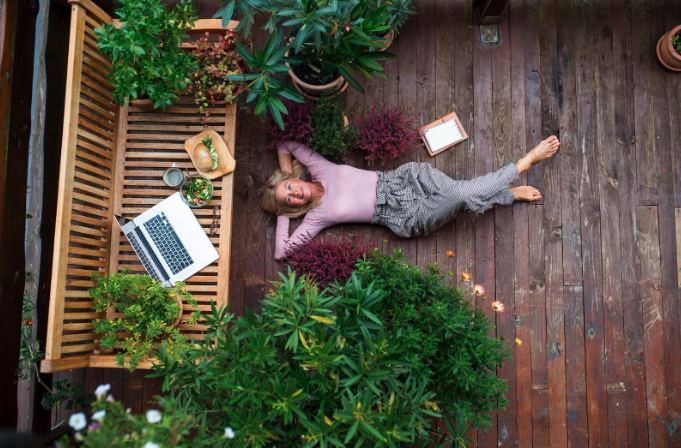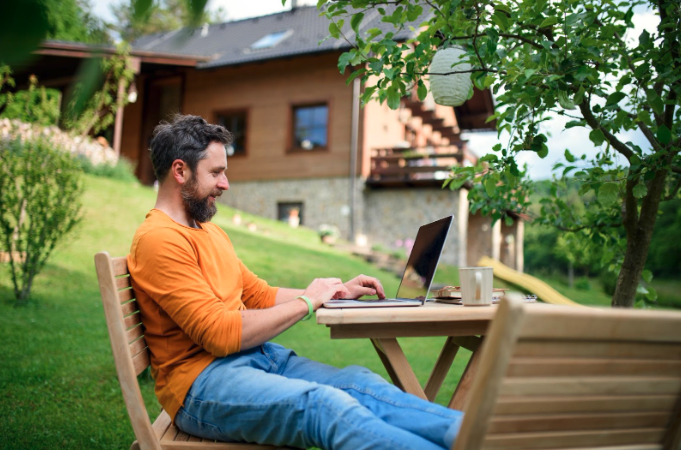- Mon-Fri 9am-4pm EST
- 888-663-4621
With the promise of fresh air, natural light, and relaxing greenery, working outdoors offers many attractive benefits, so it should come as no surprise that outdoor office spaces are becoming more common. Besides the wonderful new environment, the benefits often include lower utilities, mood enhancement, reduced stress, and even better overall health.
Choosing where your backyard office will be is one of the most important decisions you'll make throughout this entire process. After all, this choice will impact the potential and limits of its functionality and comfort.
Think about what you need to be more productive when you work. Do you need quiet seclusion and lots of natural light? Perhaps you instead prefer social settings, or darker environments. Regardless, make a list of your needs to help guide your setup.
If you're thinking about establishing any sort of construction to complement your outdoor office, make sure you don't need to get a building permit with the city first. Each city has its own requirements on what is classified as a shed, and each also defines its own requirements on setbacks and acreage allotment.
Of course, the sun is probably one of the biggest draws in dreaming of an outdoor office, but there are additional considerations to keep in mind. Direct sunlight is great for creating a bright and productive space, but you may want to add shading if you'll also use it for long-term relaxation. Shading such an umbrella or canvas will also be beneficial in keeping the sun off your back on the hotter days of the year.
Wherever you plan to put your outdoor office, one thing is for sure - you want an even surface. Working on a slope will either require a lot of additional construction, or not work at all. Take a good look at your outdoor space and look for a comfortable spot that is both flat and level.
The next thing to remember is what you'll be able to see from wherever you set up your outdoor space. For example, you might enjoy seeing a variety of flowers and other plant life at a distance from wherever you work. Alternatively, if it's a space that will also double as one for relaxation, you might instead prefer something more secluded.
Whether or not privacy is a real concern for you, it may still be beneficial for productivity by minimizing the potential distractions that can come from such an open space. Again, this all comes down to personal preferences, so go back to your list of needs from earlier and remind yourself of your priorities.
Speaking of your needs and priorities, it's also just as important to be practical. Will the space you're looking at have easy access to electricity and other utilities? Can you still work there in inclement weather? As wonderful as a potential spot might be, it doesn't mean much if it won't actually foster the environment of productivity you need to get things done.

It can feel impossible to know where to start getting furniture for an outdoor space, especially with how many options and additional considerations there are to make. That means that choosing furniture takes more than just picking out random pieces that look good online; you'll need to make a plan based on how you'll use the space and maintain it over time.
You already know you want to use this space as an office, and you have a list of needs set for that may or may not have shifted since you've chosen where you'll put it. Now's a great time to review that list and update it with new priorities you may now have.
Ideally, most of your time spent outside will be spent enjoying the spaces you've created for yourself, which makes maintenance a top priority. With some simple, regular cleaning, durable furniture like metal, teak, and wicker can stand up to just about anything for a long period of time. In addition, investing in durable furniture made from materials specifically designed for outdoor use is crucial to ensure long-term performance and longevity.
Of course, neutral and wood colors aren't the only options you have for outdoor office furniture. Plenty of manufacturers offer bright options meant to complement natural surroundings, and you can always opt for a DIY paint job if all else fails. Keep the boldest tones for cushions and accent pieces that won't be used as much, allowing them to retain their visual appeal for longer.
Outdoor furniture is no stranger to the old adage about getting what you pay for. Plastic resin, for example, looks great but only takes a year or two to become brittle under the sun. That's also true for certain wicker pieces. In other words, be sure to shop with care; if you plan to splurge anywhere on this project, do so on material quality.
It's always nice to be able to take a step onto the grass and enjoy the direct feeling of nature, but you might also take kindly to something softer underfoot like an outdoor rug. Thanks to recent textile advancements, there are many quick-drying options to choose from. Just be sure whatever you pick is specifically rated for outdoor use.

When you think about it, there are seemingly countless ways to take advantage of an exterior space. More than work itself, outdoor spaces can be used as spaces of transition and travel as you take breaks and have lunch.
Fortunately, it's not complicated to move through the planning stages, especially if you've taken the time to identify your priorities. By this point, you know what you need and you have an idea of the furniture you want to get. Here's how to start arranging all the pieces into place:
No matter where you live, outdoor conditions can be unpredictable, making it important to think about the possibilities carefully when you design this outer office space. For example, you'll want to think about weather elements such as:
Make sure the office is accessible
Creating an accommodating outdoor office means thinking about access points and seating. Accessibility is always an important consideration, even when your office isn't out in your backyard. Even though this space will be separate from your indoor living space, it's a good idea to make it easy to move between the two environments with ease, ensuring that your new office is as convenient as it is practical.
Changing scenery provides great opportunities to spark your imagination and insight, but there is always still a chance for distractions to come up, especially from pests and insects.
There are many ways you can prevent bugs, birds, and animals from invading your outdoor space. Mosquito traps, pet and child friendly pest spray, and other valuable tools to consider.
Of course, it doesn't always have to be about work! Studies show that regular breaks actually help boost productivity. Plus, they're good for your physical and mental health. In other words, your outdoor space might benefit from a dual-purpose design that enables easy relaxation.

Caring for an outdoor office space is no small feat. It requires you to plan, maintain an eye for detail, and understand the unique challenges that each season and piece of furniture can potentially bring.
Depending on your setup, this may not always be possible, but storing your furniture under coverings like awnings or canopies limits their exposure to the elements; that means less premature wear. But if you live in a climate with heavy rain or snow, this alone will not be sufficient to keep them fully protected. Certain electronics should be stored indoors at all times when not being used.
The harsher the weather your furniture will be exposed to, the more likely you will benefit from weatherproof covers. As the name suggests, they keep your furniture protected when not indoors, both in and out of severe weather. If any of your furniture is made of a porous material like wood, they're even more susceptible to long-term weather damage, so consider making this investment for them.
A deck box is a simple storage container made of a protective material, such as resin,, plastic, or metal, specifically for outdoor use. Usually, they're meant to store practical items like gardening tools, towels, and other sorts of outdoor gear, which makes them perfect for storing cushions and smaller, more fragile accessories.
If you're concerned about protecting the deck box itself, you can always take it further with specially-designed covers or anchors to keep the box securely in place.
If you've done your homework selecting outdoor furniture, you may have already decided on pieces that can withstand simple weather elements. If not, think about washable materials:
When the weather report calls for the worst, the best thing to do is to bring it inside. If it isn't feasible to store your outdoor office furniture in your home, renting a storage unit or putting it in your shed is your next step.
The research is clear: Seeing green, even for just a few seconds, boosts creativity. Putting together an outdoor office space that grants you easy access to such a view lush with greens will undoubtedly provide a wealth of inspiration that can translate to powerful benefits. If you can't set everything up all at once, you can adopt small changes and gradually scale it up as you can. At the end of the day, all the effort is worth it.
You must login to post comments.